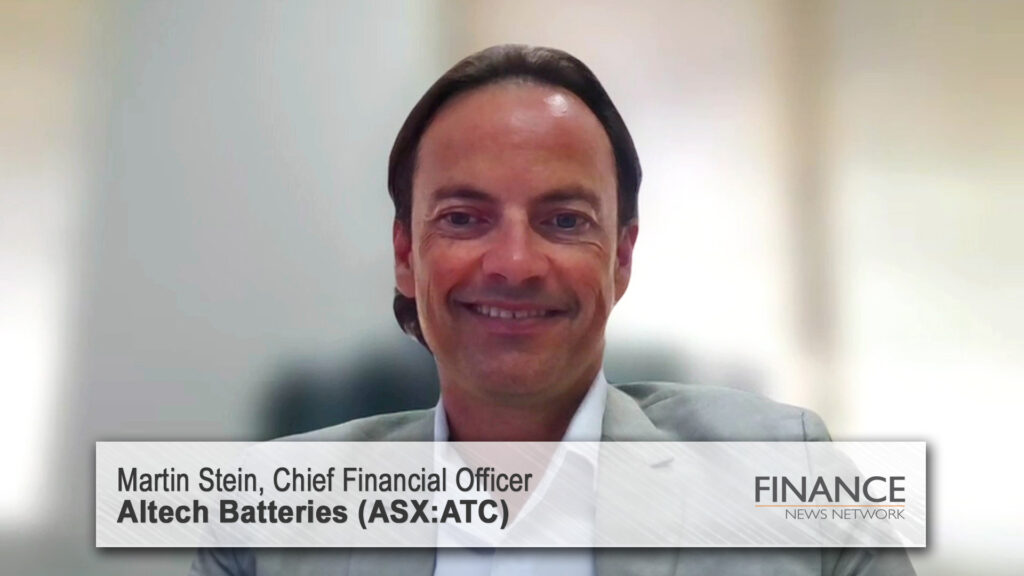Paul Sanger: I am Paul Sanger for the Finance News Network, and today, I am talking to Altech Batteries, ASX code ATC, and they have a market cap of around 87 million. Altech batteries is commercializing a 120 megawatt solid state sodium chloride battery production facility, produce one megawatt of grid packs for the European grid energy market. And it is also at the cutting edge of developing battery materials for a lithium-ion battery future by successfully incorporating silicon in graphite anodes to produce higher energy density batteries. We are talking today to Martin Stein, Altech Chief Financial Officer. Martin, welcome back to the network.
Martin Stein: Always good to be here, Paul. Thanks for having me again.
Paul Sanger: No problem. Now, Martin, Altech just released an update to the market on the progress of the company’s Cerenergy battery prototypes. Can you start by telling us about the current status of this project?
Martin Stein: Yeah. So we released, today, an update on the prototypes. Now, the Cerenergy battery, as your listeners I think are aware, is a battery that’s destined for grid storage, that uses common table salt technology, that doesn’t use lithium, copper, cobalt, graphite, and manganese. So, it has a number of advantages. Now, we’re commercializing the 120 megawatt hour plant on Altech’s land in Germany. And as part of this commercialization, we’re fabricating and building two 60 kilowatt-hour ABS-60 Cerenergy batteries. Now, this size of battery is really the building block for the one megawatt-hour grid pack, because the one megawatt-hour grid pack will have 18 of these 60 kilowatt batteries in them. So to have the prototypes fabricated is, well, in progress, and when they will be fabricated, it’ll be a really good achievement, because we’ll be able to provide those to potential customers for a real-world testing, Paul, which the proof will be in the pudding. When these prototypes are ready, the customers will test them, and it will prove the technology up.
Paul Sanger: Gotcha. And so what are the next steps for the project, and when can we expect to hear about the next level of progress?
Martin Stein: Yeah. So this year for Altech is, I think, going to be a really important year, because the first step is to finalize the definitive feasibility study for the 120 megawatt-hour plant. Now, we’ve been working on that study, beavering away at it since we entered into the joint venture with the world-leading German government research Institute, Fraunhofer, to commercialize this product. So we’re in the final stages of completing the definitive feasibility study and that will really, we think, trigger a number of positive things, because it will allow us to finalize the grant, and subsidy applications that we’ve got in place with both the European Investment Bank, and the German government to assist in construction of the plant.
The DFS will also be an important consideration for our potential customers, because they’ll be able to see all of the information related to the battery. And the finance, the remaining finance that will be non-grant and subsidy-related will also require the DFS to be able to move forward, so we’ll have this DFS finished in the next couple of months. We’ll get it out, and then we’re optimistic that offtake financing permitting will fall into place soon after that.
Paul Sanger: Let’s just talk a little more about these potential customers. What’s the status of negotiations with these, at present?
Martin Stein: Yeah, really good question, Paul, because we started the process with the offtake negotiations, sometime ago last year, in anticipation of the DFS being ready with and the prototypes actually being ready for testing. Now, we’ve actually been in advanced negotiations with two prominent German utility providers who are making the transition from fossil-fuel energy to renewable energy. They’ve expressed a lot of interest in receiving the Cerenergy batteries, so we’re in negotiations with them for the offtake. Once they get the prototypes, they can test them themselves, and then that will assist in signing an offtake agreement. We think one or two of these utility providers, maybe one, maybe two, but we think one or two of them will take up the whole 120 megawatt-hour of capacity.
Paul Sanger: Martin, many thanks for your time today.
Martin Stein: It was a pleasure, Paul. Thanks very much again.
Paul Sanger: And just before we go, just for the audience, be sure to tune into the Hidden Gems webinar this Friday lunchtime, as Altech Co will be presenting on the show. Martin, you have a great day.
Martin Stein: Thanks very much. You too.
Ends

